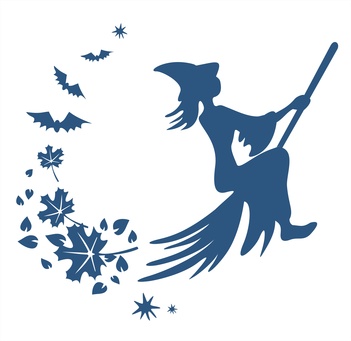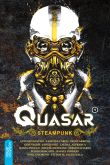 As the eyes and ears of the Horror cognoscenti are transfixed by the new season of American Horror Story, Coven, people will be talking about witches. There are innumerable stereotypes, from the kindly medicine woman in a sylvan glade to the full-blown Bride Of Satan. Each Archetype is a potent and loaded symbol, that speaks volumes about the culture and the writer that produced it.
As the eyes and ears of the Horror cognoscenti are transfixed by the new season of American Horror Story, Coven, people will be talking about witches. There are innumerable stereotypes, from the kindly medicine woman in a sylvan glade to the full-blown Bride Of Satan. Each Archetype is a potent and loaded symbol, that speaks volumes about the culture and the writer that produced it.
For the occasion, we have decided to investigate three of the most infamous Witch flicks out there: Dario Argento’s ‘The Three Mothers’ trilogy.
Suspiria, Inferno, and The Mother Of Tears span three decades and are beautiful, blood-soaked gems of what is called Giallo, Italian exploitation films, heavy on flesh, gore, and funky soundtracks.
These films are perfect microcosms of what the Horror genre, and thus the society at large, was like in a particular decade.
 Suspiria is probably the most well-known. It tells the story of Susie Bannion, a promising and beautiful ballerina, who transfers to Freiburg, Germany to attend a prestigious dance academy. It just so happens the academy is run by a coven of witches.
Suspiria is probably the most well-known. It tells the story of Susie Bannion, a promising and beautiful ballerina, who transfers to Freiburg, Germany to attend a prestigious dance academy. It just so happens the academy is run by a coven of witches.
Suspiria sets the standard for the trilogy: ornate Gothic sets, resplendent in primary colors, with an eerie, otherworldly soundtrack, and a laundry list of filth and violent death. In Suspiria, you will see maggots fall into girls’ hair, someone is hung by the neck from a stained-glass ceiling, some other unfortunate more or less drowns in barbed wire. It is a legitimately stark, terrifying movie that grabs the viewer by the throat and never lets go.
Suspiria is probably the most accomplished of the three films. It at least attempts to set the mood. There’s a full 15 MINUTES long lead in, to set the mood, but it doesn’t take for the supernatural deaths to begin. The characters are deeper and more human, particularly Susie Bannion, played by Jessica Harper. She is a timeless female protagonist, strong but still vulnerable.
Suspiria also has a truly CLASSIC soundtrack, a psychotropic black mass by Italian prog rockers Goblin, who scored a number of Argento films. It’s full of screeching incantations and scraping strings. It’s delightfully ’70s and its raw crudity makes it that much more disconcerting. Those that are looking to get into the wide, wild, weird world of horror soundtracks, this is one of the most iconic.
 Inferno was actually a lot better than I remembered it, although it is a genre exercise, through and through. This is pure Giallo, an excuse to make a horror film and dispatch people in new and interesting ways.
Inferno was actually a lot better than I remembered it, although it is a genre exercise, through and through. This is pure Giallo, an excuse to make a horror film and dispatch people in new and interesting ways.
Inferno begins with Rose, a poet living in New York City. She discovers a book called The Three Mothers, about three ancient evil witches, The Mothers of Sighs, Tears and Shadows. She begins to suspect that her apartment building houses one of the malignant entities. She writes to her brother Mark, a musicology student in Rome, begging him to come. Rose is brutally stabbed to death before he arrives.
What follows is an unfurling tapestry of supernatural mystery, full of good ol’ fashioned horror cliches. There’s a curmudgeonly antiquarian (who is later eaten by rats), black cats, a lunar eclipse and a deadly effective reveal at the end!!!
I remembered the film as an endless series of tormented individuals, lumpingly pursued by shambolic humanoids, in the style of John Carpenter‘s Prince Of Darkness. Upon rewatching, I found it to be a delightfully atmospheric play of eerie lighting, ancient mysteries, and bloody corpses, a total thrill for the horror aficionado.
The soundtrack from Keith Emerson, of Emerson, Lake, and Palmer, which integrated several themes from Verdi‘s Nabucco, used prominently throughout the film, gives the film a classical edge. The music and visuals are beautifully synced, really driving the action and adding metric tons of tension.
Inferno will appeal to all devotees of ’80s horror and any fanatics who love to be deluged in blood and gothic ambiance.
 The Mothers Of Tears didn’t appear for 27 years. It says a lot about what modern horror has become and the pitch black status of the current collective unconscious. It is one of the most truly antisocial films I’ve ever seen, and it’s easy to understand why British film censors felt that this type of Video Nasty has no redeeming qualities. In The Mother Of Tears you see a woman get skewered, tons of bared breasts, lesbian make-out scenes, rape, riots, a woman eating afterbirth, and countless other atrocities. It will make you want to wash your eyes out with bleach. It is absolutely not for the squeamish (even the review is not for the squeamish), nor the faint of heart. During one of the inevitable modern pop out scares, I felt as if I had been hit in the chest with a cattle prod.
The Mothers Of Tears didn’t appear for 27 years. It says a lot about what modern horror has become and the pitch black status of the current collective unconscious. It is one of the most truly antisocial films I’ve ever seen, and it’s easy to understand why British film censors felt that this type of Video Nasty has no redeeming qualities. In The Mother Of Tears you see a woman get skewered, tons of bared breasts, lesbian make-out scenes, rape, riots, a woman eating afterbirth, and countless other atrocities. It will make you want to wash your eyes out with bleach. It is absolutely not for the squeamish (even the review is not for the squeamish), nor the faint of heart. During one of the inevitable modern pop out scares, I felt as if I had been hit in the chest with a cattle prod.
The Mother Of Tears follows Inferno‘s formula, nearly verbatim, but takes it to a whole new apocalyptic level. An art historian receives a letter, along with an ancient urn, sealed in wax. They unseal the urn, and the massacre begins immediately. It is saved from merely being a bloodbath with a sympathetic backstory for Asia Argento (the director’s daughter), who plays Sarah Mandy, whose mother was a powerful white witch. Both her parents were murdered when she was very young, but Eliza Mandy‘s ghost plays the Deus Ex Machina, driving the plot along, telling Sarah what she needs to know. There’s some hokey seance effects, but it’s almost a relief, as a respite from the carnage. Mater Lachrymarum is the baddest of the wicked witches, with some true black magick caught on film. It’s easy to understand why the Medieval world was so terrified of these malevolent creatures.
The Mother Of Tears is an example of all the best and worst of what modern horror has to offer. We’ve broken down all taboos, and anything goes, letting people play out the depths of their twisted imaginations. The negative side is that it is often at the expense of atmosphere and subtlety, although this seems to be improving since this movie’s release in 2007.
 Argento‘s 3 Mothers are the most extreme version of the wicked witch. In Medieval times, life was beset by chaos and uncertainty: crops failed, livestock became diseased, and women miscarried or died in childbirth. Humanity hates feeling powerless and such catastophes didn’t jive well with the beneficent God in the Sky worldview; they needed someone to blame. The outcasts, the disfigured, fringe-dwellers of society were scapegoated and persecuted. This is the ugliest side of patriarchy’s allegiance to rationality, and it is rather interesting that these Archetypes linger on in the beginning of the 21st century.
Argento‘s 3 Mothers are the most extreme version of the wicked witch. In Medieval times, life was beset by chaos and uncertainty: crops failed, livestock became diseased, and women miscarried or died in childbirth. Humanity hates feeling powerless and such catastophes didn’t jive well with the beneficent God in the Sky worldview; they needed someone to blame. The outcasts, the disfigured, fringe-dwellers of society were scapegoated and persecuted. This is the ugliest side of patriarchy’s allegiance to rationality, and it is rather interesting that these Archetypes linger on in the beginning of the 21st century.
Frequently, the persecuted were practitioners of more ancient, earth-based religions. They might be plant-healers or midwives. The victims were nearly always women. It just goes to show how terrified men are of empowered women and what a threat that intuition and emotion are to Pure Reason, the true God of the 20th century. It allowed us to separate ourselves from Nature, and rape the land for fun and profit. It separated us from our bodies, letting cancers and stress-related illnesses run rampant. It has also allowed us to live in total ease and comfort, and no one wants to let that go! It is rather telling that The Mother Of Tears was dispatched by being impaled by a giant, pointy statue. Normal life is able to resume, and everybody lives happily ever after. The woman has been put back in her place.
Looking closely at the myth of Witchcraft brings up all manner of interesting insights. The stereotype of the Big Bad Witch will always linger, but it is fading, as we sink further and further into what I have been calling the atavistic return, the fusion of logic and Ancient Wisdom. The rise of Harry Potter and fantasy in general, and the gaining popularity of Burning Man culture indicates a trend, mark my words.
American Horror Story: Coven plays on the FX Network at 10 pm.
Suspiria @ imdb.











Recent Comments